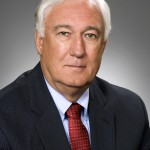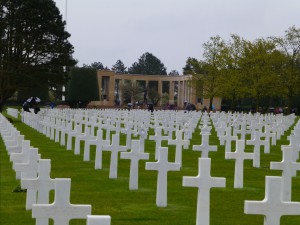(Editor’s Note: Former Jackson EMC President Randall Pugh, a native of Buford, and his wife visited World War II sites in Europe recently. Here is his perspective on his trip.—eeb)
By Randall Pugh | Last Saturday, June 6, marked the 71st anniversary of the D-Day invasion of Europe during World War II. On that day 160,000 allied troops landed along a 50 mile stretch of the Normandy coast in northern France. Less than a year later Adolph Hitler was dead and the war in Europe was finally over.
The Normandy campaign lasted from June 6 until September 1, 1944, when Paris was finally liberated. It is estimated that more than 29,000 American ground troops, airmen, and navy personnel died during this campaign. More than 105,000 were wounded.
Today the beaches at Normandy are tranquil and peaceful. The French bring their families there for vacation and tourists come to satisfy their curiosity about the war. Inland the villages with their narrow streets and stuccoed brick or rock walls have been rebuilt and life goes on as usual. The once killing fields are now large pastures with herds of grazing cattle or green fields of wheat and canola plants.
There is little visual evidence of that great conflict of seven decades ago. There is the occasional German concrete bunker or pill box sitting atop the 90 foot bluffs the American, British, Canadian and French had to fight their way up once they made it across the beaches. There is the German 150MM gun battery at Longues-sur-Mer overlooking the English Channel at Gold Beach…just sitting there in their ghost like positions as if they are awaiting orders to fire their 100 pound shells toward the allied ships 15 miles off shore.
Remnants of the artificial Mulberry harbor are still visible at Gold Beach where the allies following D-Day unloaded hundreds of thousands of new troops and thousands of tons of materials and supplies for the troops fighting their wa
y inland. The huge bomb craters remain on top of Pointe-du-Hoc where allied bombers attempted to knock out the big German guns placed there to protect the coast from invasion. Because that failed, the Army Rangers of the First Division scaled the 90 foot cliffs to take out the guns early on D-Day. Of the 245 men who began the mission that day only 94 survived.
Then there is the American Cemetery at Omaha Beach … a stark reminder of the ultimate sacrifice made by so many of our youth in the prime of their life. Ten thousand American GIs lie at rest here.
On May 24 my wife, Patricia, and I had the privilege of attending a special America Memorial Day ceremony at the American Monument at Omaha Beach. It was a most sobering and touching experience and one that will remain in our hearts and memories forever. Dignitaries from several countries (including France) expressed their sincere gratitude to America for the sacrifices it made in the liberation of their countries. They concluded by placing wreathes in honor of the fallen.
Following Normandy we traveled to the Netherlands, where in September, 1944, the British and American airborne units jumped behind enemy lines to capture the bridges at Nijmegen and Arnhem (A Bridge Too Far) in an attempt to end the war early. That operation failed and cost the allied troops thousands of dead and wounded. Then on to Bastogne where the foxholes of Easy Company of the 101st Airborne remain today. At Luxemburg we visited the American Cemetery where General George S. Patton is interred. He was probably the greatest military strategist of the war.
We traveled to Berchtesgaden in the Bavarian Alps where Hitler and his senior political and military officials had their secondary central command headquarters inside an elaborate underground bunker complex.
High atop the mountain above Berchtesgaden is the Eagles Nest, Hitler’s mountain top retreat. We ended our trip with a visit to the infamous Dachau concentration and extermination camp near Munich, Germany. Here, late in the war, from the time the prisoners stepped off the train that brought them there, until they were processed through the gas chambers and their bodies placed in the crematory furnaces took 90 minutes. The Nazi machine was very efficient!!!
We as Americans; as teachers; as educators; as public officials, as media representatives…..all need to commit ourselves to constantly telling the story of the great tragedy of World War II to our children, our grandchildren, and to the new emigrants coming to our country…lest they forget!!












Follow Us